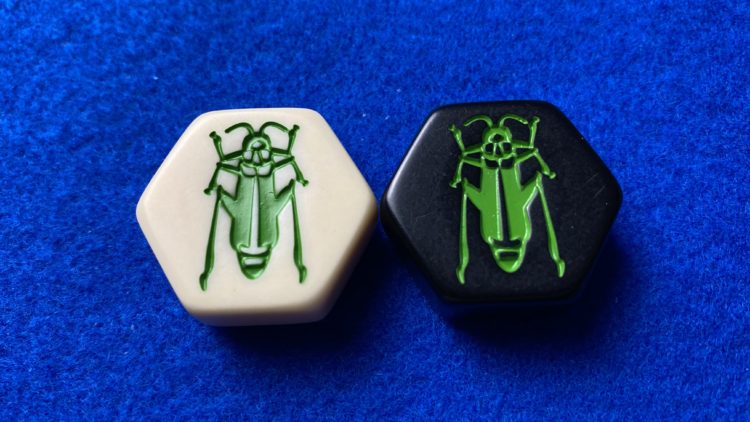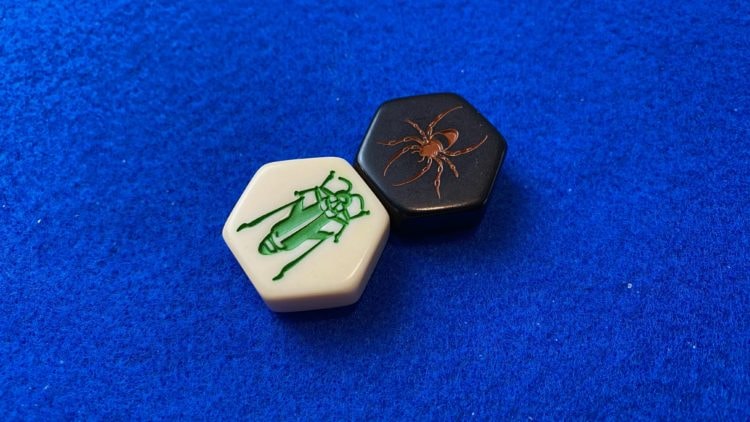
OBJECTIVE OF Hive: In order to win, surround your opponent’s Queen Bee tile
NUMBER OF PLAYERS: 2 players
MATERIALS: Hive game set, playing surface
TYPE OF GAME: Abstract strategy & tile game
AUDIENCE: Kids, Adults
INTRODUCTION OF HIVE
Hive is an abstract strategy game designed by John Yianni and published in 2001. Since its release, there have been a few different iterations such as Hive Pocket and Hive Carbon. The game has also seen expansions that introduced new pieces. It is also available in digital form on STEAM. The instructions below will describe how to play the base game.
MATERIALS
There are a variety of different pieces. Each piece type has its own move set.
QUEEN BEE

The Queen Bee can only be moved one space per turn. It must be added to the Hive by the fourth turn. A player may not move any other pieces around the Hive until their Queen Bee is played.
BEETLE

The Beetle can only move one space per turn, but it may also move on top of another piece. Once on top of the Hive, the Beetle may move around one space at a time. A piece that has a Beetle on top of it may not move. Beetles may move down into spaces that normally block other pieces from entering. A Beetle may be moved on top of another Beetle in order to block it.
GRASSHOPPER

The Grasshopper can jump in a straight line across the Hive. In order to do this, there must be a row of connected tiles for the Grasshopper to jump over. If there are any gaps in the row, the jump cannot be made. Because of this ability, the Grasshopper can also move into spaces otherwise blocked for other insects.
SPIDER

The Spider is able to move three spaces. It must always move three spaces, and it is not allowed to move back to the space it came from. As it moves, it must always be in contact with another piece.
SOLDIER ANT

The Soldier Ant can move as many spaces as the player wishes as long as it stays in contact with another piece.
SETUP
Each player will begin with all of the black or all of the white pieces. To decide who gets which color, one player should hide one piece of each color in their hands. Hold the pieces out hidden in closed hands. The opposite player picks one of the hands. Whichever color that player chooses is what they will play as. Similar to Chess, white goes first.
THE PLAY
Player 1 begins by placing one of their pieces on the playing space. Player two follows by choosing a piece and playing it adjacently to the first piece. The two pieces must be touching side to side. This begins the Hive, and the One Hive Rule (see below) must be followed from this point on.

New pieces may be introduced to the game each turn. When a player adds a new piece to the Hive, it can only touch other pieces of its own color. For example, when Player 1 adds a new white piece to the Hive, it can only touch other white pieces. If a player is unable to follow this rule, they cannot add a new piece to the Hive that turn. Once a piece has been added to the Hive, it cannot be removed.

A player must introduce their Queen Bee to the Hive by their fourth turn. A player cannot move any of their pieces until their Queen Bee has been placed. After it has been placed, a player can either add a new piece to the Hive or move one existing piece around it.

ONE HIVE RULE
The Hive must always be connected with all of the pieces touching. A player may never move a piece in such a way that the Hive disconnects or is split into two.
LOCKED IN
With the Grasshopper and Beetle being the exceptions, most pieces are moved by sliding them. Once a piece is blocked in such a way that the piece is unable to be moved, it is stuck.
NO MOVEMENT OR PLACEMENT AVAILABLE
When a player is unable to add a new piece to the Hive or move any of their pieces, they must pass their turn. They will continue to pass each turn until they can move again or until their Queen Bee is surrounded.
WINNING
Once a player’s Queen Bee is surrounded, they lose. In the event that both Queen Bees become surrounded at the same time, the game is a draw. A stalemate occurs when both players are only able to move the same two pieces repeatedly without a resolution.
- TRIPLE SNAKES - February 15, 2021